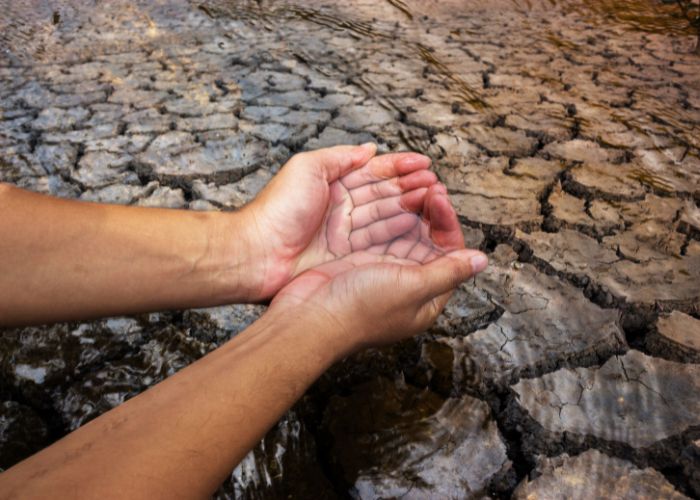A number of autonomous communities have taken measures to reduce water consumption. Municipalities in areas traditionally less affected by drought are also turning off the water for certain uses or at times.
This is happening, for example, in Andalucia, Galicia, Catalonia, Cantabria and Castile and León. Here, the drought is having a direct impact on water users. Other sub-regions, such as Asturias and the Valencian Community, still have sufficient water resources. Moreover, they are confident about their water supply. However, that does not mean that they are not looking forward to the rains that will fall in the autumn.
Exceptional situation
In autumn 2021, the Hydrographic Confederation of the Guadalquivir already declared the exceptional situation caused by the exceptional drought in 10 of the 23 territorial units of scarcity. Months later, in March 2022, the declaration of exceptional situation was extended to ‘all territorial units’ in the region.
The Hydrographic Confederation (CH) of the Duero did the same in June this year for four of the water systems that contribute most to the basin. These are those of the Támega-Manzanas, the Tera, the Carrión and the Pisuerga. Furthermore, on 14 July 2022, the CH del Duero Summit decided to adopt exceptional measures for the rational use of water resources for irrigation in those same systems and in the lower reaches of the Spanish part of the Duero River. Seven days later, the declaration of exceptional situation was extended to the Torío-Bernesga, Lower Duero and Órbigo systems. Thus, the measures in Torío-Bernesga and Tera provide for maximum irrigation allocations and adapted irrigation, which also applies to parks and gardens.
At the same time, procedures have been initiated for the government to approve a decree declaring the drought. And, therefore, adopting a series of additional measures.
Low capacity
In total, the CH Duero has 18 reservoirs that can store up to 2,878 cubic hectometres. At present, they are at 44.5% capacity with 1,218 cubic hectometres. Whereas a year ago they were at 57.3% of their total capacity.
In Cantabria, the volume of the Ebro reservoir is currently 263 hm3 , which is 48.8% of its total capacity. In 2021 the volume was be 298 hm3.
Real threat to Galicia’s water supply
The Consellería de Infraestructuras states that in Galicia river levels are ‘the lowest since measurements were taken in the Galicia-Costa delimitation’. They therefore insist that there is a ‘real threat’ to water supplies in several areas of Galicia.
Measures have been taken by municipal councils to raise awareness among citizens ‘and to prepare for other more complex scenarios’. The areas supplied by the Baiona and Zamáns reservoirs and by the Lérez and Anllóns rivers are ‘of greatest concern with a serious risk of a shortage alert’ in the Cabe and Limia rivers.
In addition to the measures taken by the municipalities, the Consellería also points to the Xunta’s new drought plan, which was approved in June. Depending on the severity of the situation, there is also a responsibility to apply the same measures. These include the reduction of water supplies for cities and industry, and the possibility of temporary interruptions to the water supply. It is up to municipalities to analyse which forms of water use have lower priority. They also have to work on ‘leaks in municipal networks’. ‘They lose an average of 40%, but it can go up to 60% and 80% in some places’.
According to the Xunta, 104 municipalities in Galicia currently have emergency plans to deal with the drought, 46 of which are in the Galicia-Costa region. Of the large cities, only Santiago de Compostela has an emergency plan.
Declaration of exceptional situation extended to ‘all territorial units’ in the region.
Balearic Islands
The Balearic Islands are also suffering from the effects of the drought. In Ciutadella (Menorca), the town council has decided to temporarily close the showers and footbaths in the municipality’s seven bays and beaches in order to save water. It has not rained for more than 75 days. However, the municipality believes it can forego this service in the current situation.
Navarre, Basque Country and Valencia region
Navarre applies distribution keys and supply restrictions on the left bank of the Ebro. Different measures are being introduced in a number of municipalities. In Erro, for example, irrigation is banned in Mezkiritz, Biskarreta-Gerendiain and Lintztoain. And, furthermore, the supply is cut off at night. The municipality of Moncayo has also banned the watering of green areas.
The Valencian Community will not face any water restrictions for the time being. However, the regional Ministry of Agriculture, Rural Development, Climate Emergency and Ecological Transition has called on the sectors and society to use water ‘rationally’, as ‘waste is not an option’.
In the Basque Country, the water supply of over 90% of the population is ‘guaranteed in the medium term’, despite the drought of recent weeks and even in a scenario of ‘limited rainfall’, according to the Basque government. The ‘biggest’ problems are in the Urdaibai region and in small towns in the Llanada Alavesa. There, it is necessary to strengthen the supply infrastructure.
In contrast to many other rivers, the drought situation in the Júcar River is ‘absolutely normal’. All territorial units fall within this norm, both in case of prolonged drought and scarcity. There is no need to consider restrictions in the region. All needs are ‘covered and guaranteed for the current hydrological year’.
Aragón
Finally, in Aragón, the mayor of Huesca, Luis Felipe, issued an order on Friday for a ‘responsible and moderate’ consumption of drinking water. This was necessitated by the current meteorological situation in the autonomous community, with a ‘remarkable’ lack of rainfall in recent months. As a result, the level of water supply in the city of Huesca was lower than normal at this time of year.
Also read: Drought threatens olive cultivation


